For almost 40 years, since China’s well-known”reform and opening” movement beginning in the late 1970s, the economic relationship has been the solid bedrock of a stable and largely cooperative U.S.-China relationship. Despite the recent complaints about being treated unfairly in each other’s markets, there is no denying that both Washington and Beijing have benefited tremendously from their economic interdependence.
China has grown from a very-low income economy into a middle-income economy and might even join the club of developed economies if the current growth trend holds for another decade. This is an amazing development by any standard, and the United States should be proud of being a major contributor to China’s success. Meanwhile, despite recent rhetoric complaining about China’s intellectual theft and siphoning of American jobs, the U.S. economy has enjoyed a very long period of low inflation due to cheap imports from China, thus contributing to the United States’ hegemonic position around the world as more resources could be diverted to overseas missions.
It is within this context that the recent changes in U.S.-China relations and in particular the ongoing trade war threat are puzzling. Tensions have already been high in recent years as both China and the United States have made strategic moves that invited suspicion from the other side. China’s so-called new assertiveness in areas like the South China Sea, international development finance via the Asian Infrastructure Investment Bank (AIIB), and pursuit of the the Belt and Road Initiative has signaled a new grand strategy in the eyes of many American policymakers—a strategy that ultimately aims at surpassing the United States as the world’s leading power, ultimately driving the United States out of Asia strategically.
China, on the other hand, has viewed U.S. moves in Asia, like the Obama administration’s “Pivot to Asia” and most recently the decision to initiate a trade war, as clear evidence of an intention to slow down or even block China’s rise and the realization of the Chinese dream. The most recent decision by the U.S. government to ban sales of U.S. technologies to one of China tech giants, ZTE, has led to strong nationalist reactions in China. Chinese President Xi Jinping, as a result, also commented on this episode indirectly by calling for twice the efforts into building China’s own core technology. This was only natural because the ZTE case clearly showed that China still lags far behind the United States in terms of several key technologies; without this, China cannot become a developed economy and hence the Chinese dream lies in jeopardy.
Interestingly, there are growing voices within both China and the United States calling for more self-sufficiency within the economic relationship. The Chinese case is relatively straightforward because China’s ongoing technological bottleneck can only be resolved with home-grown technologies, however long that might take. The U.S. case is a bit different as it is already the indisputable global leader in technology. However, the U.S. worries that given its open society and markets, China could either learn from or even steal U.S. technologies, which ultimately could harm U.S. strategic interests should there be a U.S.-China conflict over the South China Sea or Taiwan issue in the future.
Already we have seen a significant decrease of Chinese FDI into the United States in 2017, partly due to increasingly strict scrutiny of any Chinese investment in the country. There is even quiet talk about putting more limits on Chinese students who come to the US to study so-called STEM subjects and banning all Confucius Institutes, which are viewed as agents of the Chinese Communist Party. Needless to say, some of these proposals border on imagined fear and even outright discrimination; still, the important thing is the bigger strategic context within which all of these moves are occurring.
It is unfortunate that all of this is happening now. To make sense of all this, we also need to look at the global trade environment, which has been under attack from nationalist and populist forces. The United States is not only trying to decouple itself from the Chinese economy; it is also trying to become independent from other major trading partners like Mexico and the European Union. Perhaps the global multilateral trading frameworks, including the World Trade Organization, have reached their full potential in growing major economies. If so, then it is only natural that all major economies are taking a second look at the old model of globalization and seeking a new age of globalization. In the U.S.-China case, the brewing strategic rivalry between the two certainly does not help the already strained trade relationship.
What does this all mean? Very likely it means that globalization and the world are entering into a new era of economic decoupling instead of economic interdependence. A healthy degree of economic decoupling might not necessarily be a bad thing because domestic divisions resulting from unchecked globalization need time to heal. We will also need a new round of globalization that puts more emphasis on inclusive development and co-prosperity. Until then, we will see more trade frictions and the like; let’s hope they will not turn into full-blown trade wars and bring us back to the dark age of the 1930s.

































